RBSE Solutions for Class 5 English Chapter 2 Let’s Learn Pranayam
Rajasthan Board RBSE Solutions for Class 5 English Let's Learn English Chapter 2 Let’s Learn Pranayam Textbook Exercise Questions and Answers.
RBSE Class 5 English Solutions Chapter 2 Let’s Learn Pranayam
Activity -I.
A. Put the pictures of different stages of pranayam in correct order:
(प्राणायाम की इन विभिन्न अवस्थाओं के चित्रों को सही क्रम में लगाएँ।)
Answers:

Answers:
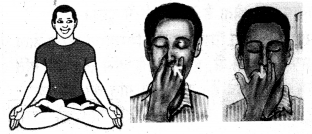
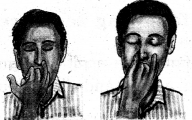

B. Match the names with the pictures.
(नामों का चित्रों के साय मिलान करें)
Answer:
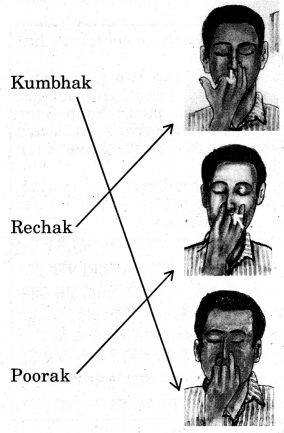
C. Write T for true and F for false statements.
(प्राणायाम की विभिन्न अवस्थाओं के चित्रों को सही क्रम में लगाएँ)
1. Shivam went to the park with Raju one day.
2. They saw some people making posters in the middle of the park.
3. The control and extension of breath is called pranayam.
4. Pranayam increases our heart rate.
5. Evening is the best time to do pranayаt.
6. Kumbhak is the process of holding breath.
Answer:
1. (False)
2. (False)
3. (True)
4. (False)
5. (False)

D. Answer the following questions :
निम्नलिखित प्रश्नों के उत्तर दीजिए।
Class 5 English Chapter 2 Hindi Translation Question 1.
Where did Nitin and Shivam go one day in the morning ?
नितिन और शिवम एक दिन सुबह के समय कहाँ गये?
Answer:
One day, in the morning, Nitin and Shivam went to a park.
एक दिन, सुबह के समय, नितिन और शिवम एक उद्यान में गए।
RBSE Class 5 English Chapter 2 Question Answer Question 2.
What is pranayam.
प्राणायाम क्या है?
Answer:
Pranayam is control and extension of the breath.
प्राणायाम-सांस का नियन्त्रण एवं विस्तारण करना है।
Class 5 English Chapter 2 Let's Learn Pranayam Hindi Translation Question 3.
What are the benefits of pranayam?
प्राणायाम के क्या लाभ हैं?
Answer:
Benefits of pranayam :
1. It balances our energy and stabilizes moods.
2. It improves our lungs and heart functions.
3. It helps in weight loss.
4. It improves our concentration and focus.
5. It clears nasal passage.
6. It is good for blood circulation.
प्राणायाम के लाभ:
1. यह हमारी ऊर्जा को संतुलित एवं दिमाग को स्थिर रखता है।
2. यह हमारे फेंफड़े तथा हृदय के कार्यों में उन्नति करता है।
3. यह वजन कम करने में सहायता करता है।
4. यह हमारी एकाग्रता तथा ध्यान में उन्नति करता है।
5. यह नाक की नली (सांस नली) को साफ करता है।
6. यह रक्त संचार के लिए अच्छा है।

Class 5 English Chapter 2 Let's Learn Pranayam Question 4.
What is poorak ?
पूरक क्या है?
Answer:
In this process, right nostril is pressed with right hand thumb. Then we breathe in slowly from the left nostril. This is done till the lungs are full.
इस प्रक्रिया में नासिका के दाहिने छिद्र को सीधे हाथ के अंगूठे से दबाते हुए एवं नासिका के बाएँ छिद्र से धीमे से सांस अन्दर लेते हैं। ऐसा तब तक करते हैं जब तक कि फेफड़े भर न जाएँ।।
Let's Learn Pranayam Question 5.
How do you close your left nostril while doing rechak ?
'रेचक' करते समय आप अपनी नासिका के बाएँ छिद्र को कैसे बन्द करते हैं? (नोट-आपकी पाठ्य-पुस्तक में right शब्द गलत छपा है। रेचक की प्रक्रिया में बाएँ छिद्र को बन्द किया जाता है।)
Answer:
While performing rechak, we close the left nostril with our ring finger.
'रेचक करते समय, हम अपनी अनामिका उँगली द्वारा नासिका के बाएँ छिद्र को बन्द करते हैं।
Activity - II
A. Fill in the missing letters to complete the words given below.
(निम्नलिखित शब्दों को पूर्ण करने हेतु लुप्त अक्षर भरें।)
1. n_str_I
2. br_ _th_
3. th_gh
4. th_mb
5. an_le
6. r_l_ _se
Answer:
1. nostril
2. breathe
3. thigh
4. thumb
5. ankle
6. release

B. Complete the following sentences.
निम्नलिखित वाक्यों को पूरा कीजिए।
Kumbhak is ..........................
Rachak is ..........................
Poorak is ..........................
Answer:
Kumbhak is the process of holding breath.
कुंभक सांस रोकने की प्रक्रिया है।
Rachak is the process of breathing out.
रेचक सांस छोड़ने की प्रक्रिया है।
Poorak is the process of breathing in.
पूरक सांस लेने की प्रक्रिया है।
Activity - III.
Look at the following sentences taken from the lesson.
पाठ में से लिए गये निम्नलिखित वाक्यों को देखिए।
• Sit calmly on a mat and close your eyes.
• You can also do it in the evening but there should be a gap of four hours after the last meal.
• Hold your breath for 5 to 10 seconds or only as long as you comfortably can.
|
Each of the above three sentences has two parts. In first sentence, the two parts have been joined by 'and', in second sentence, the two parts have been joined by 'but' whereas in third sentence, the two parts have been joined by 'or'. |We use 'and' for adding information, 'or' for giving alternatives and but' for different information. उपरोक्त तीन वाक्यों में प्रत्येक के दो भाग हैं। प्रथम वाक्य में दोनों भागों को 'and' द्वारा जोड़ा गया| है, दूसरे वाक्य में दोनों भागों को 'but' द्वारा जोड़ा गया है जबकि तीसरे वाक्य में दोनों भागों को 'or' द्वारा जोड़ा गया है। जानकारी को जोड़ने के लिए हम 'and' का प्रयोग करते हैं, विकल्प देने के लिए 'or' का प्रयोग करते हैं तथा असमान जानकारी देने के लिए हम 'but' का प्रयोग करते हैं। Complete the following sentences using 'and', 'but' or 'or' निम्नलिखित वाक्यों को 'and', 'but' अथवा 'or' लगाकर पूर्ण कीजिए। |
1. We went to the station ............. the train had gone.
2. Most people work in day ....... sleep at night.
3. The bus was crowded ................. managed to get in.
4. On a warm summer day, will you wear a black shirt ......... a white shirt?
5. I wanted to buy a newspaper ...... didn't have enough money.
6. We went home ................... played Kabaddi.
7. My grandmother is eighty years old ................. her vision is still sharp.
8. I called him .................. he did not answer
9. Will you take milk ..................... lassi?
Answer:
1. but
2. and
3. but
4. or
5. but
6. and
7. but
8. but
9. or

Activity - IV.
The names of some body parts are given below. Your teacher will read them aloud and you will point at them.
नीचे शरीर के कुछ भागों के नाम दिए गए हैं। आपके अध्यापक उन्हें पढ़कर सुनाएँगे तथा आप उन पर संकेत
(a) nostrils
(b) ring finger
(c) lungs
(d) middle finger
(e) thigh
(f) little finger
(g) heart
(h) legs.
Answer:
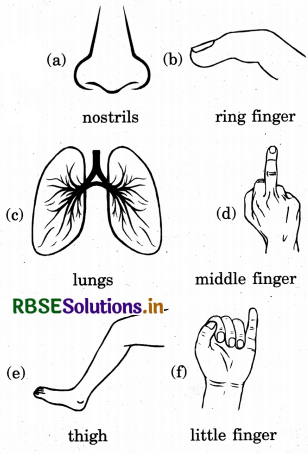
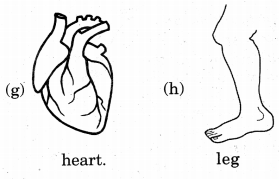

Activity - V.
You do Surya Namaskar in your prayer session daily. With the help of your teacher, write the process in your notebook step by step and paste their pictures.
अपने प्रार्थना सत्र में आप रोजाना 'सूर्य नमस्कार' करते हैं। अपने अध्यापक की सहायता लेकर इस प्रक्रिया को अपनी नोट बुक में क्रमशः सूचीबद्ध करें एवं उनकी तस्वीर लगाएँ।
Answer:
Surya Namaskar
1. Pranamasana (Prayer pose)
Stand at the edge of your mat, keep your feet together and balance your weight equally on both the feet. Expand your chest and relax your shoulders. As you breathe in, lift both arms up from the sides and as you exhale, bring your palms together in front of the chest in prayer position.
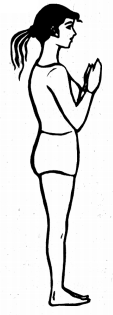
प्रणामासन अपने दोनों पैरों को जोड़कर चटाई के छोर पर खड़े हो जाएँ तथा अपना वजन दोनों पैरों पर समान रूप से डालें। अपनी छाती को चौड़ाकर कंधों को ढीला छोड़ें। सांस अन्दर की ओर लेते समय अपनी दोनों भुजाओं को अपने बगल से ऊपर उठाएँ तथा सांस बाहर की ओर छोड़ते समय अपनी हथेलियों को एक साथ नमस्कार की मुद्रा में अपनी छाती के सामने लाएँ।

2. Hastauttanasana (Raised Arms pose)
Breathing in, lift the arms up and back, keeping the biceps close to the ears. In this pose, the effort is to stretch the whole body up from the heels to the tips of the fingers.
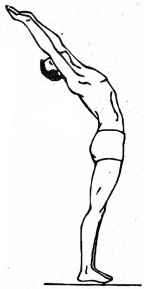
हस्त उत्तानासन सांस अन्दर की ओर लेते समय, अपनी भुजाओं को ऊपर तथा पीछे की तरफ उठाएँ एवं अपनी द्विशिर पेशियों को कानों के समीप लाएँ। इस मुद्रा में, एड़ियों से लेकर उँगलियों के छोर तक, सम्पूर्ण शरीर पर खिंचाव डालने पर जोर दिया जाता है।
3. Hasta Padasana (Hand to Foot pose)
Breathing out, bend forward from the waist, keeping the spine erect. As you exhale completely, bring the hands down to the floor, beside the feet.
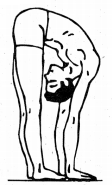
हस्तपादासन सांस बाहर की ओर छोड़ते हुए, रीढ़ को सीधा रखते हुए, कमर की ओर से आगे की तरफ झर्के। सांस को पूर्णतः बाहर की ओर छोड़ने के पश्चात् हाथों को फर्श की ओर लाएँ एवं पैरों के निकट टिका दें।
4. Aekpaadprasarnaasana
Breathing in, push your Left leg back, as far back as possible. Bring the right knee to the floor and look up.
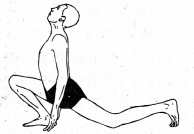
सांस अन्दर की ओर लेते हुए, अपनी बायीं टांग को, जितना हो सके, उतना पीछे की ओर ले जाएँ। अपने दाहिने घुटने को फर्श पर लाते हुए ऊपर की ओर देखें।

5. Parvatasana (Stick pose)
As you breathe in, take the left leg back and bring the whole body in a straight line.
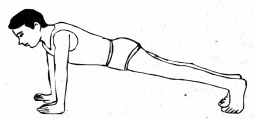
पर्वतासन सांस अन्दर की ओर लेते हुए बांई टांग को पीछे लेते हुए, सम्पूर्ण शरीर को एक सीधी रेखा में लेकर आएँ।
6. Ashtanga Namaskara (Salute With Eight Parts or Points)
Gently bring your knees down to the floor and exhale. Take the hips back slightly, Slide forward, rest your chest and chin on the floor. Raise your posterior a little bit.

अष्टांग नमस्कार अपने घुटनों को धीरे से फर्श पर रखते हुए सांस को बाहर की ओर छोड़ें। कूल्हों को हल्का सा पीछे की ओर लेते हुए आगे की तरफ खिसकें, अपनी छाती एवं ठोड़ी को फर्श पर टिका दें। अपने पिछले भाग को हल्का सा ऊपर उठा दें।
7. Bhujangasana (Cobra pose)
Slide forward and raise the chest up into the Cobra posture. You may keep your elbows bent in this pose, the shoulders away from the ears. Look up.
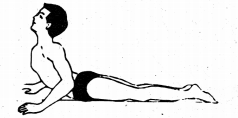
भुजंगासन आगे खिसकते हुए अपनी छाती को "कोबरा" की भांति ऊपर उठाएँ। इस मुद्रा में आप अपनी कोहनियों का मोड़कर, कंधों को कानों से दूर ले जा सकते हैं। ऊपर की तरफ देखिए।
8. Adhomukha Svanasana Breathing out, lift the hips and the tail bone up, chest downwards in an 'inverted V' (A) posture.
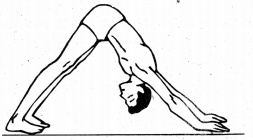
अधोमुख श्वानासन सांस को बाहर की ओर छोड़ते हुए, कुल्हों एवं दुमची को ऊपर की तरफ उठाएँ, एवं छाती को उल्टे 'V' की मुद्रा में रखे। (A)
9. Ashwa Sanchalanasana (Equestrian pose) Breathing in, bring the right foot forward in between the two hands, left knee down to the floor, press the hips down and look up.
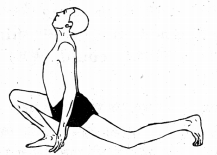
अश्व संचालनासन सांस को अन्दर की ओर लेते हुए, अपने दाहिने पैर को दोनों हाथों के मध्य, आगे की ओर लेकर आएँ। बाएँ घुटने को फर्श पर रखते हुए कूल्हों को नीचे की ओर दबाएँ एवं ऊपर की तरफ देखें।

10. Uttarasana Breathing out, bring the left foot forward. Keep the palms on the floor. You may bend the knees, if necessary.

उत्तरासन सांस को बाहर की ओर छोड़ते हुए अपने बाएँ पैर को आगे लाएँ। हथेलियों को फर्श पर रख दें। अगर आवश्यकता हो, तो आपे घुटनों को मोड़ सकते हैं।
11. Hastauttanasana (Raised Arms pose)
Breathing in, roll the spine up, hands go up and bend backwards a little bit, pushing the hips slightly outward.
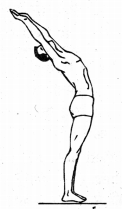
हस्त उत्तानासनं सांस अन्दर की ओर लेते हुए मेरुदण्ड को घुमाएँ, हाथों को ऊपर की तरफ, हल्का -सा पीछे की तरफ ले जाएँ। कूल्हों को हल्का सा बाहर की तरफ बढ़ाएँ।
12. Tadasana As you exhale, first straighten the body, then bring the arms down. Relaxing in this position, observe the sensations in your body.

ताड़ासन सांस बाहर की तरफ निकालते हुए, | पहले शरीर को सीधा करें, तत्पश्चात्, भुजाओं को नीचे की तरफ लाएँ। इस मद्रा में शिथिल होकर, शरीर में हलचल, की अनुभूति करें।

Can you name these yogasans ?
क्या आप इन योगासनों के नाम बता सकते हैं?
Answer:
1. Chakrasana (चक्रासन)
2. Sarvangasana (सर्वाङ्गासन)
3. Halasana (हलासन)
4. Urdhvamukhasvanasana (उर्ध्वमुखश्वानासन)
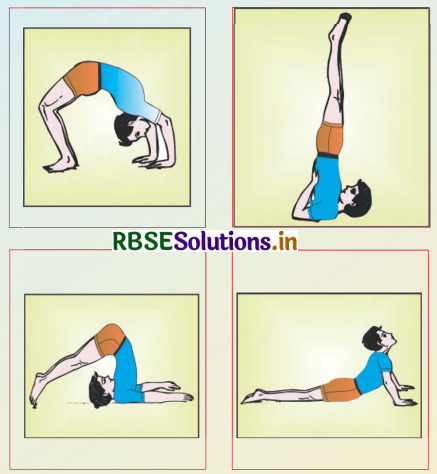
Q. Which of these do you perform in the prayer assembly ?
इनमें से कौन-से
आसन आप प्रार्थना-सभा के दौरान करते हैं?
Answer:
1. Chakrasana (चक्रासन)
2. Halasana (हलासन)
Q. What changes have you felt in your body after performing yogasans ?
योगासनों को करने के पश्चात् आपने अपने शरीर में क्या बदलाव महसूस किए हैं?
Answer:
After performing yogasans, I feel my body more active and strong.
योगासनों को करने के पश्चात मैं अपने शरीर को अधिक फुर्तीला एवं मजबूत महसूस करता हूँ।

Let's learn about pranayam and its benefits.
(आइए, प्राणायाम एवं उसके लाभों के बारे में जानें।)
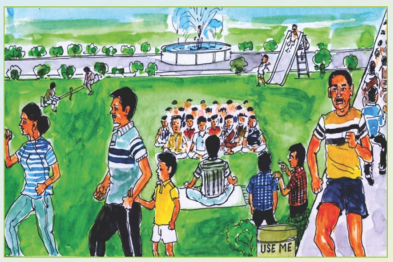
Let’s Learn Pranayam Summary and Translation in Hindi
Shivam and ....... near them. (Page 47)
Word-meanings-pleasant (प्लेश्ज़न्ट) = सुहावनी, सुखद। track (ट्रैक) = मार्ग-पट्टी। poses (पोज़िज) = मुद्राएँ। wondered (वन्ड:ड) = अचम्भित होकर सोचने लगा। curiosity (क्यूरियॉसिटि) = जिज्ञासा। park (पा:क) - उपवन, उद्यान।
हिन्दी अनुवाद-शिवम और नितिन कक्षा 5 के विद्यार्थी थे। एक दिन वे जल्दी उठ गए। यह एक सुहावनी सुबह थी। वे सुबह की सैर के लिए एक उद्यान में गए। उन्होंने उद्यान में अनेक लोगों को देखा। उनमें से कुछ उद्यान के चारों ओर बने मार्ग पर दौड़ रहे थे। बच्चे खेल रहे थे। उद्यान के बीचों-बीच, कुछ लोग बैठे हुए थे तथा विभिन्न मुद्राएँ बना रहे थे। शिवम अचम्भित होकर सोचने लगा कि वे क्या कर रहे हैं। जिज्ञासापूर्वक, वे दोनों मित्र उनके निकट गए।
There ........ expectancy. (Pages 47-48)
Word-meanings - instructions (इंस्ट्रक्शन्म) = दिशा-निर्देश। somebody. (सम्बडि) = कोई। control (कन्ट्रोल) = नियंत्रण। extension (इक्स्टे न्शन) = विस्तारण। practising (प्रैक्टिसिंग) = अभ्यास करना। reduce (रिड्यूस) = कम करना। breathing rate (ब्रीदिंग रेट) = सांस लेने की गति। heart rate (हा:ट रेट) = हृदय-गति । blood pressure (ब्लड प्रेश) = रक्तचाप। relaxes (रिलैक्सिज़) = तनाव मुक्त करना। increases (इन्क्रीजिज़) = वृद्धि करना। life expectaney (लाइफ़ एक्स्पेक्टन्सि) = आयु।
हिन्दी अनुवाद-वहाँ एक योग शिक्षक थे जो दिशा-निर्देश दे रहे थे। उन्होंने कहा-"मेरे प्रिय मित्रों, आइए आज की योग कक्षा में प्राणायाम करना सीखें।" "प्राणायाम क्या होता है?" किसी ने पूछा। प्राणायाम-सांस का नियन्त्रण एवं विस्तारण करना होता है। इसके अभ्यास से, हम अपनी सांस लेने की गति को कम कर सकते हैं। सांस की गति को कम करने के बहुत फायदे हैं। यह हमारी हृदय गति को धीमा करता है, रक्तचाप को कम करता है तथा मस्तिष्क एवं शरीर को तनाव मुक्त रखता है। प्राणायाम हमारी आयु को बढ़ाता है।

"Pranayam ......pranayam." (Page 48)
Word-meanings-empty (एप्टि) - खाली। stomach (स्टॅमक) = पेट। preferably (प्रिफ़रेब्लि)- अधिक अच्छे रूप में। gap (गैप) = अन्तराल। meal (मील) - भोजन। joined (जॉइन्ड) = में शामिल हो गए। got interested (गॉट इन्ट्रस्टिड) - रुचि उत्पन्न हो गई। seeking (सीकिंग) = माँगना। permission (प:मिशन) = इजाज़त। listing (लिस्टिंग) = सूचीकरण। steps (स्टेप्स)- तरीके/ चरण। group (ग्रुप) = समूह। हिन्दी अनुवाद-"प्राणायाम खाली पेट किया जाना चाहिए, अधिक अच्छा रहेगा यदि इसे सुबह के समय किया जाये। आप इसे संध्या के समय भी कर सकते हैं, परन्तु भोजन के बाद चार घंटों का अन्तराल अवश्य होना चाहिए।" शिवम एवं नितिन को रुचि उत्पन्न हो गई तथा योग शिक्षक से इज़ाजत माँगने के बाद वे समूह में शामिल हो गए। शिक्षक ने प्राणायाम करने के क्रम को सूचीबद्ध करना प्रारम्भ कर दिया।
Step-I ..... 'Kumbhak'.(Pages 48-49)
Word-meanings-calmly (काम्लि) - शांतिपूर्वक। mat (मैट) = चटाई। close (क्लोज़) - मूंदना/बन्द करना। left (लेफ्ट)- बाँया। ankle (एकल) = टखना। right (राइट) - दायाँ । thigh (थाइ) = जांघ। posture (पॉस्चर) =' अवस्था। is called (इज़ कॉल्ड) = कही जाती है। in the beginning (इन द बिगनिंग) = आरम्भ में। slightly (स्लाइट्लि) = जरा-सा। to sit in this pose= इस अवस्था में बैठना। worry (वरि) = परेशान, होना, चिन्ता करना। learn (ल:न) = सीखना। nostril (नॉस्ट्रल) = नासिका छिद्र। thumb (थम) - अंगूठा। breathe (ब्रीद) = सांस लेना। lungs (लंग्ज़) - फेफड़े। process (प्रॉसेस) - कार्यविधि, प्रक्रिया। hold (होल्ड) = रोकना। comfortably (कम्फॅटब्लि) = आराम से।
हिन्दी अनुवादस्टेप-1-चटाई पर शान्तिपूर्वक बैठ जाएँ तथा अपनी आंखें मूंद लें। स्टेप-11-बांए टखने को दाहिनी जांघ पर रखें। स्टेप-III अब अपना दाहिना टखना, बांयी जांघ पर रखें। (यह अवस्था 'पद्मासन' कहलाती है।) आरम्भ में, इस अवस्था में बैठना आपको जरा सा कठिन लग सकता है। परेशान न हों, थोड़े से अभ्यास के द्वारा, आप इसे सीख जायेंगे। स्टेप-IV-अपनी नासिका के दाहिने छिद्र को अपने सीधे हाथ के अंगूठे से दबाएँ एवं नासिका के बाँए छिद्र से धीमे से सांस अन्दर लें। ऐसा तब तक करें जब तक कि आपके फेफड़े भर न जाएँ। (सांस अन्दर लेने की यह प्रक्रिया 'पूरक' कहलाती है।) स्टेप-V-अपनी सांस को 5 से 10 सेकण्ड के लिए अथवा जितने लम्बे समय के लिए आप आराम से रोक सकते हैं, रोक लीजिए। (सांस को रोककर रखने की यह प्रक्रिया 'कुम्भक' कहलाती है।)
Step-VI Now release ...... the yoga class daily. (Pages 50-51)
Word-meanings-release (रिलीज़) = स्वतन्त्र करना। ring finger (रिंग फिंगॅर) = अनामिका उँगली। rounds (राउन्ड्ज़) - बारी। thanked (थैक्ट) = आभार प्रदर्शित किया। decided (डिसाइडिड) = निश्चय किया। attend (अटेन्ड) = उपस्थित रहना।
हिन्दी अनुवादस्टेप-VI–अब अंगूठे को हटा कर अपनी अनामिका उँगली द्वारा नासिका के बाएँ छिद्र को बन्द करें। अब अपनी नासिका के दाहिने छिद्र से सांस धीरे से बाहर की तरफ छोड़ें। (सांस बाहर की ओर छोड़ने की यह प्रक्रिया 'रेचक' कहलाती है।) स्टेप-VII अब, नासिका के दाहिने छिद्र से सांस अन्दर की ओर लें। स्टेप-VIII अपनी सांस को दोबारा रोकें। स्टेप-IX-अब अपनी नासिका के दाहिने छिद्र को अपने अंगूठे से दबाएँ तथा बाएँ छिद्र से सांस बाहर की ओर छोड़ें।
स्टेप-X-आप शुरुआत में 5 बार ऐसा कर सकते हैं तथा इसे 15-20 बार तक बढ़ा सकते हैं। प्राणायाम हमारी आयु को बढ़ाता है।

प्राणायाम के लाभ/फायदे
1. यह ऊर्जा को संतुलित एवं दिमाग को स्थिर रखता
2. यह फेंफड़े तथा हृदय के कार्यों में उन्नति करता है।
3. यह वजन कम करने में सहायता करता है।
4. यह एकाग्रता तथा ध्यान में उन्नति करता है।
5. यह नाक की नली (सांस नली) को साफ करता है।
6. यह रक्त संचार के लिए अच्छा है। शिवम और नितिन 'प्राणायाम' सीखकर खुश हुए। उन्होंने योग शिक्षक को धन्यवाद दिया और रोज़ाना उद्यान में आकर नियमित रूप से योग की कक्षा में उपस्थित रहने का निश्चय किया।
